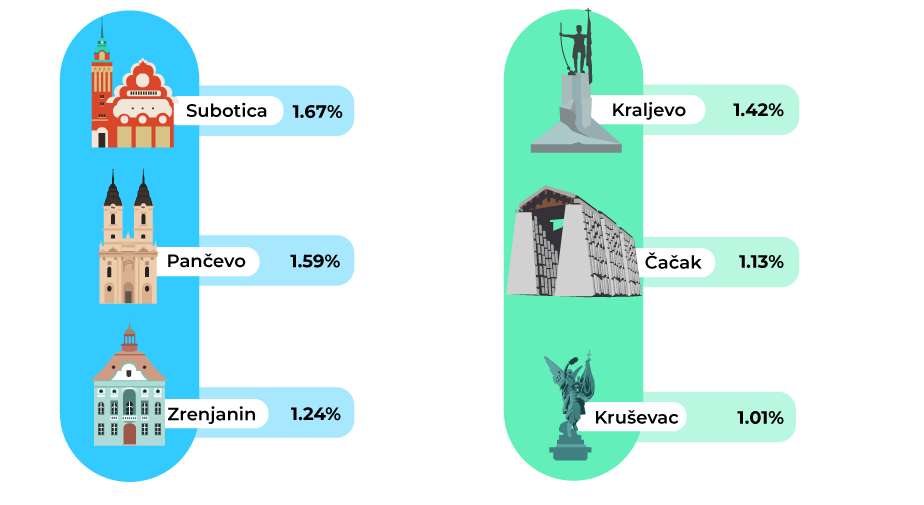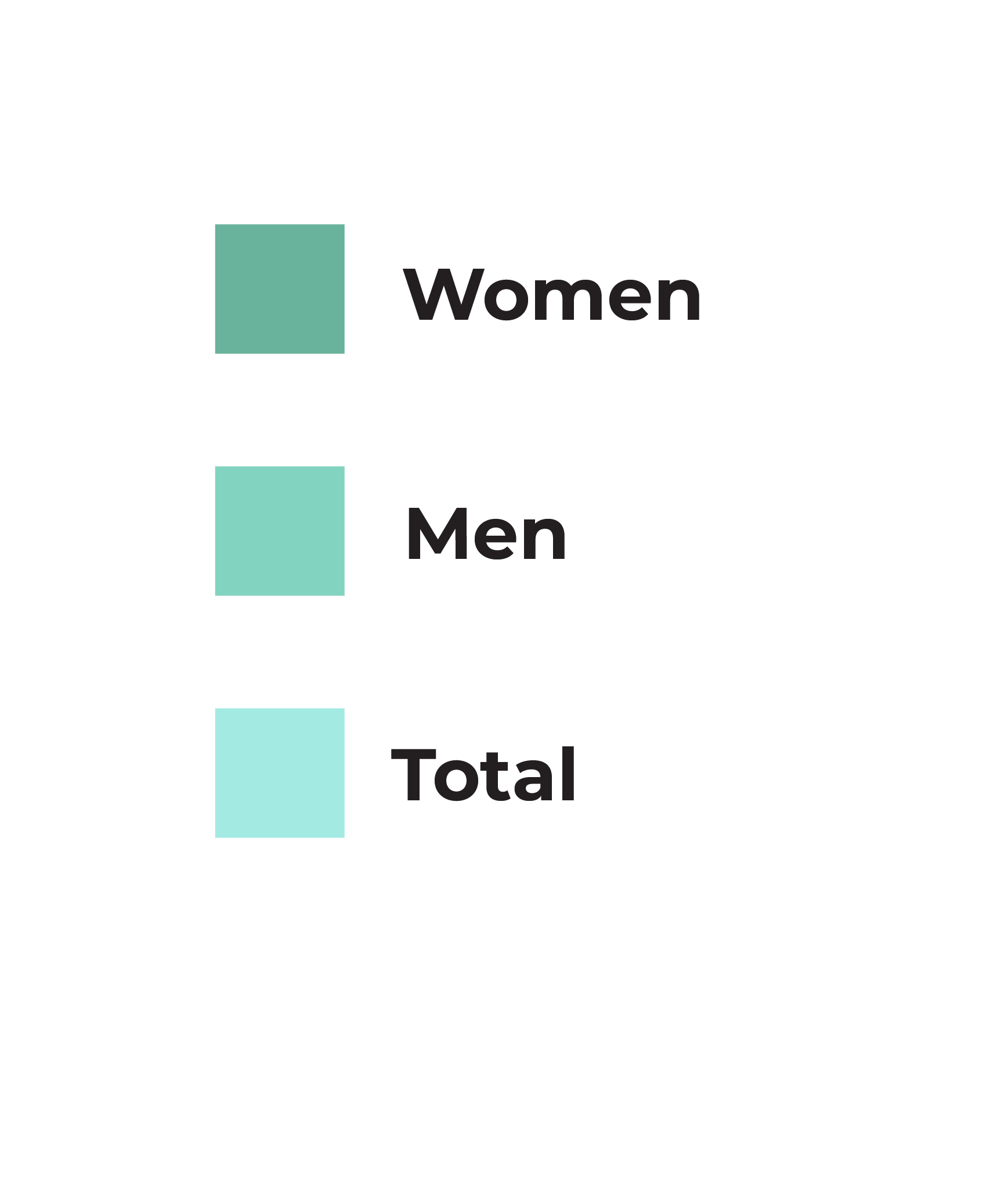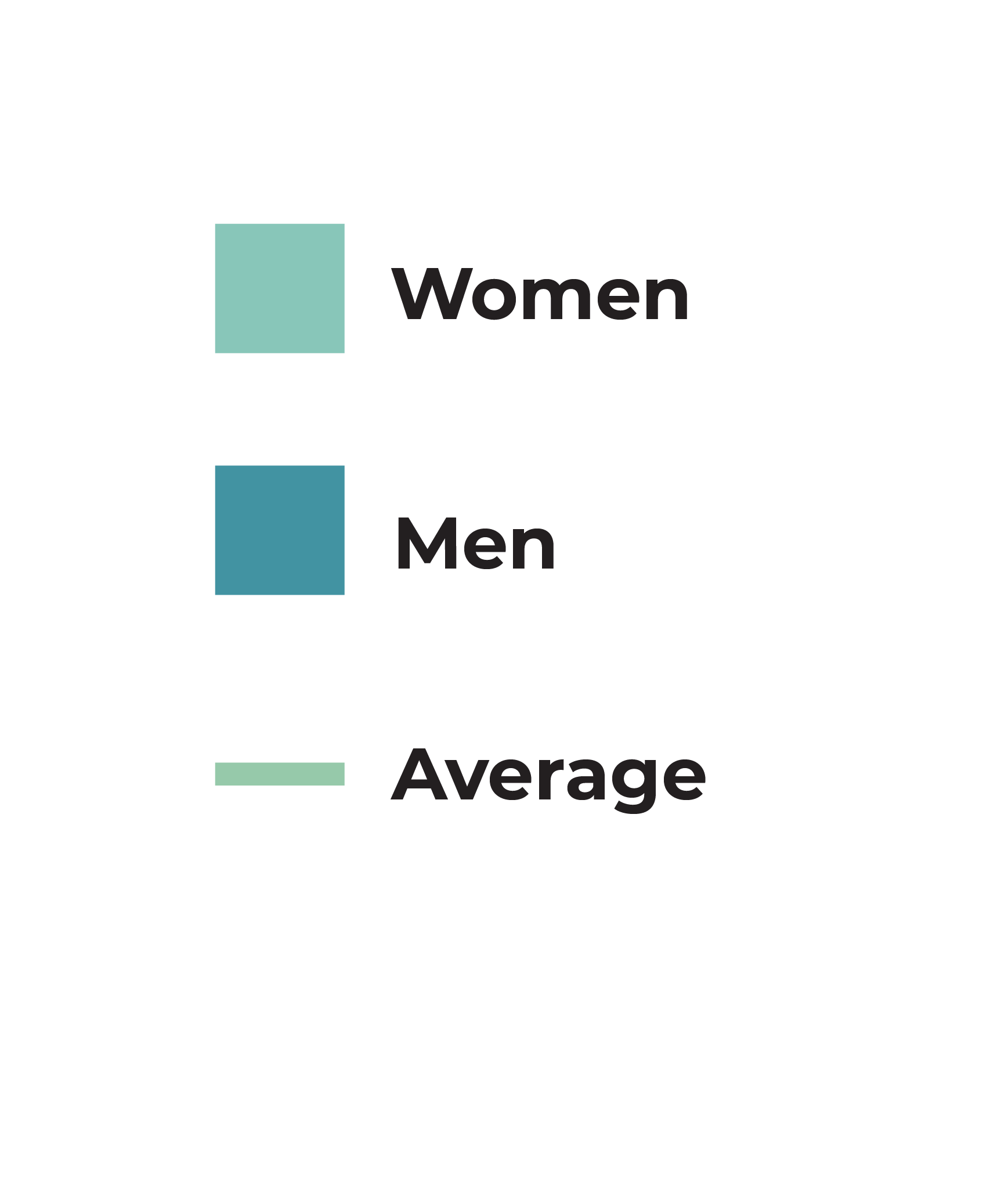GIGMETAR REPORT MAY 2024
The overall freelancer population on the three largest digital platforms (Guru, Freelancer, and Upwork) has grown by a modest 2.3 percent. Unpacking this figure reveals strong growth of 9.9 percent on Upwork, the dominant marketplace, coupled with a contraction on Freelancer (-10.2 percent) and Guru (-7.5 percent). The numbers suggest the gig labour market is continuing to evolve as the first-ranked platform sees increasing concentration.
HIGHLIGHTS

Revival? Following on from the sudden dramatic drop seen in the Autumn 2023 measurement, the latest data revealed a modest uptick in the gig workforce amounting to 2.3 percent.

Obstacles for new entrants. Freelancers without previous experience were the most likely to leave the gig labour market, with the gap between experienced workers and new entrants continuing to widen.

Unexpected popularity: occupations recording exponential growth. Sales and marketing support attracted the most interest from freelancers, with the gig worker population in this occupation nearly doubling after a growth rate of 46.5 percent. Professional services were the runner-up, following an increase of nearly one-third (32.3 percent).

Growing importance of women freelancers. The share of women has increased by 1.4 percentage points (pp) to 35.1 percent of the overall Serbian gig workforce. At 49.5 percent, sales and marketing support saw the highest growth, followed by software dev and tech at 43.5 percent.
RESULTS IN DETAILS
Despite economic uncertainty, freelancer supply and demand have continued to grow. On the supply side, the World Bank estimates online gig workers account for 12 percent of the global workforce, holding particular promise for women and youth in developing countries. The market is far larger than previously thought, with online gig workers numbering between 154 and 435 million worldwide. Conversely, and perhaps surprisingly, demand for online gig work has grown more strongly in less developed countries. However, trends suggest online freelancing is becoming increasingly challenging, with demand shifting towards more sophisticated skills: more than one-half of all online gig workers now have postgraduate degrees whilst the share of freelancers with lower educational attainment (secondary school or less) has been declining (to 31 percent). Demand for programmers and data analysts has been particularly pronounced, as reflected in the ability of freelancers in these occupations to command the highest hourly rates.
Multiple factors have come together to stall growth in Serbia’s digital work market. Trends in the conventional labour market have meant some freelancers have been seeking traditional employment arrangements with Serbian or foreign companies. Issues intrinsic to the labour market have also played a major role: according to last year’s Payoneer report, Serbian online gig workers have been facing a major increase in global competition, struggling to land new jobs, and seeing growth for their services rise less quickly than in other parts of the world. These issues were in large part due to some occupations not being cost-competitive and Serbian gig workers lacking appropriate skills, putting renewed pressure on their positions, earnings, and ability to find work in the online market. Any assessment must also consider changes to the Serbian regulatory environment, in particular new tax rules that have made it easier for freelancers to report income earned from online platform work whilst also introducing more stringent controls for undeclared earnings.
Two major trends were recorded with freelancers seeking to transition into conventional employment. Firstly, nearly all those who reported wishing to make this change were seasoned gig workers. Secondly, hourly rates in this group were nearly 30 percent higher than the average. These findings suggest traditional employment arrangements were more attractive for many successful freelancers, and that the advantages of gig work go hand in hand with drawbacks that have been leading these workers to look for more stable working arrangements with clearer rights and obligations.

% OF GIG WORKERS BY ADMINISTRATIVE DISTRICT
Continuing measurement of the gig population by region reveals the largest part of this population (86.2 percent) lives and works in 28 Serbian cities and towns. The findings of this survey also provide evidence for the increasing urbanisation of freelancers, which echoes the results of recent studies that show ever greater agglomeration of online gig workers.
Some Serbian regions were particularly notable for their freelancers. Vojvodina led the way with growth standing at an impressive 14.5 percent, whilst Belgrade saw an increase of 11 percent.Read more ...
Overall statistics. The latest measurement shows Belgrade accounted for 42.8 percent of the total freelancer population, with Novi Sad coming second at 12.8 percent, followed by Niš at 7.7 percent and Kragujevac at no more than 2.3 percent.
The latest survey found the freelancer population exceeding 1 percent in 11 towns and cities. Apart from large administrative centres, these were Subotica, Pančevo, Kraljevo, Zrenjanin, Čačak, and Kruševac, with Jagodina joining the list for the first time.
Administrative centres and large conurbations. Data for administrative centres of NUTS2 regions bear out the assumption that gig workers are increasingly concentrated in major conurbations. In addition to Belgrade, where the share of the local gig workforce in the total population rose from 40.2 to 41.8 percent, Novi Sad also saw growth.
Gender structure and regional differences. Freelancer growth was completely balanced in terms of gender in regions where the trend was at its most pronounced, such as Belgrade and Vojvodina. In Šumadija and Western Serbia, the male freelancer workforce remained virtually unchanged, but the number of women gig workers rose by 9.4 percent. In Southern and Eastern Serbia, men entering the gig labour market for the first time outnumbered women by a factor of more than two, deepening the market’s gender imbalance.

GIG WORKERS BY OCCUPATION
.

The charts in this report show the distribution of gig workers by occupation according to the Online Labour Index (OLI) taxonomy developed by the Oxford Internet Institute. The six occupations covered are professional services, clerical and data entry, creative and multimedia, sales and marketing support, software dev and tech, and writing and translation.
The past six months were marked by an increase in workforces across all occupations, save for writing and translation, which saw a 6 percent contraction. One likely explanation is the increasingly common use of AI-based translation tools, especially as Upwork has been one of the best freelance writing and translation marketplaces.
The expansion has not been balanced evenly, however, with sales and marketing support and professional services leading the way with growth rates of 46.5 and 32.3 percent, respectively. Robust global demand for these services seems to have attracted many new Serbian workers to the occupations. Read more ...
Differences in growth rates by occupation. Growth in sales and marketing support and professional services has brought about a qualitative improvement in the gig market, with these two best-paid areas gaining relative importance. Clerical and data entry also saw robust expansion (at 12.2 percent). Still, any increase in this occupation threatens to undermine the quality of the overall labour supply as the jobs in this sector are the least well-paid, at high risk of being replaced by AI tools, and under the greatest pressure from global competition. Growth of slightly over 4 percent was registered by the remaining two occupations, software dev and tech and creative and multimedia.
Changes to the relative importance of individual occupations. Apart from clerical and data entry, whose share edged up, the overall structure shifted in favour of sales and marketing support and professional services, with the combined share of these two occupations growing by more than 4.2pp. The remaining three occupations – creative and multimedia, software dev and tech, and writing and translation – saw comparable contractions of -1.5pp on average.
Restructuring is a key trait of the market. The main conclusion to be drawn from these trends is that, even with a modest growth rate, restructuring is in progress which may have major consequences for the long-term resilience and quality of the Serbian online gig work market. It remains to be seen whether Serbia is shifting to a market dominated by better-paid occupations.
REGIONAL GIG WORKERS AS % OF TOTAL, BY OCCUPATION
Šumadija and Western Serbia registered the largest change. Here, professional services saw the highest growth rate of as much as 72.7 percent, with writing and translation recording the largest contraction, of -11.7 percent. These findings should be viewed with some caution, however, as the region was home to the country’s smallest gig workforce: only 14 out of every 100 Serbian online freelancers were based in this area.
Belgrade, Vojvodina, and Southern and Eastern Serbia registered similar changes in professional services and clerical and data entry, with more pronounced differences seen in the remaining occupations.Read more ...
Šumadija and Western Serbia were the exception. Just like professional services, sales and marketing support registered substantial growth, with the freelancer population growing by 57.6 percent. This region also saw gig workers declining in as many as four occupations (clerical and data entry, creative and multimedia, software dev and tech, and writing and translation).
Balanced changes in other regions. Belgrade, Vojvodina, and Southern and Eastern Serbia saw growth in all occupations. Writing and translation provided the sole exception in Southern and Eastern Serbia, where the workforce contracted by -3.7 percent.
Key differences were found in the pace of growth, with two groups of occupations emerging. Professional services and clerical and data entry recorded strong growth that was comparable across all regions. On the other hand, the larger variance was evident in the other occupations. For instance, the sales and marketing support workforce grew more than twice as quickly in Vojvodina (at 58.9 percent) than in Southern and Eastern Serbia (where the growth rate was 27.8 percent).


% OF REGIONAL GIG WORKERS BY OCCUPATION

Creative and multimedia boasted the largest freelancer workforce, whilst gig workers in professional services were the least numerous. The Belgrade market was characterised by the most favourable structure, with two-thirds of all freelancers engaged in the best-paid occupations.
A key feature of Šumadija and Western Serbia was the robust growth of professional services and sales and marketing support, bringing the share of these two occupations in the regional workforce from 11.1 percent to 17.6 percent in just six months.
The differing growth rates for individual occupations have been able to better balance the gig work supply. The ratio of the most populous occupation (creative and multimedia) to the least numerous one (professional services) stood at 4.2 in the latest survey, a significant reduction from the 5.3 seen in the previous measurement. Read more ...
General trends and Belgrade idiosyncrasies. Although not particularly significant, the differences in growth rates by region and occupation have affected the structures of regional markets. Creative and multimedia has remained the largest occupation across all regions, whilst professional services are still the smallest. Moreover, the order of occupations by size has remained the same throughout Serbia save in Belgrade, with creative and multimedia followed by software dev and tech, clerical and data entry, writing and translation, sales and marketing support, and professional services. Belgrade is an exception in that sales and marketing support has now risen into third place by size, making the structure of gig work supply in Belgrade the most closely aligned with global demand.
Southern and Eastern Serbia. The survey has revealed many highly localised trends. For instance, Southern and Eastern Serbia saw professional services and sales and marketing support record the highest growth, at above 20 percent, whilst the remaining three occupations (clerical and data entry, creative and multimedia, and software dev and tech) rose by less than 10 percent. Writing and translation was the sole occupation in this region to shrink, although the fall was relatively modest (at 3.7 percent).
Šumadija and Western Serbia. This region registered the largest shifts in the structure of its occupations despite having the slowest growth rates. One of the features here has been the large slump in software dev and tech and writing and translation. The decline of software dev and tech, the best-paid occupation, outpaced the fall in creative and multimedia by a factor of three.
Vojvodina and Belgrade. These two regions registered the largest increase in gig workforces, with nearly identical trends seen across all occupations. Both Vojvodina and Belgrade saw their relative shares grow in professional services, clerical and data entry, and sales and marketing support, with Belgrade adding more freelancers in these occupations than Vojvodina. Conversely, these northern Serbian areas recorded declining shares in creative and multimedia and writing and translation, a trend more pronounced in Vojvodina. The Vojvodina region was the only part of Serbia to see an increase, albeit a modest one, in its relative share of gig freelancers in software dev and tech.
Balancing in progress. The narrowing of the gulf that separates the largest and smallest occupation continues a trend seen in all previous measurements, although the convergence was now far more prominent than in past surveys. The gap closed across all regions, but Šumadija and Western Serbia led the way (there the differential fell from 7.1 to 4.1) whilst Vojvodina registered a far smaller but apparent reduction (from 6.4 to 5.4). These developments suggest the digital labour market is becoming more balanced across all regions, a trend that holds the promise of more sustainable development and greater resilience.

GIG WORKERS BY GENDER
Women gig workers are continuing to gain in relative importance. These freelancers accounted for 35.1 percent of the total online gig workforce in the latest measurement, placing Serbia among moderately gender-balanced online gig work markets.
At 53.8 percent of the total workforce, freelancers with previous experience in online gig work outnumbered those who had no such experience. The gender breakdown was similar, although men with prior experience were slightly more numerous, at 54.4 percent, than women, where the share was 52.6 percent.Read more ...
Women freelancers continued to see robust growth. Over the past six months, the share of women gig workers in the total population has increased from 33.7 to 35.1 percent. Even though this ratio was much higher than the averages for other regions, such as Asia (at 25 percent) or Africa (24 percent), Serbia still lagged far behind Southeastern Europe (43 percent) and, in particular, North America (50 percent).
Market leavers. Men who had prior experience with platform work have become more numerous, with 1,195 experienced freelancers registered for every 1,000, in contrast to the previous measurement where the ratio had been 1,000 to 1,107. This finding suggests that mainly experienced freelancers tended to remain on platforms, as well as that more recent entrants who found themselves unsuccessful or lacked perseverance in finding work were the ones more likely to leave. Another possible explanation for these results may have been the existence of alternatives in the traditional labour market and the availability of offline work with Serbian employers. Nevertheless, the relative absence of disparity between more and less experienced online gig workers of both genders suggests the pull of the digital freelancing market has remained powerful.

% OF GIG WORKERS BY GENDER AND OCCUPATION

The online gig market is becoming increasingly attractive to women, with their increase outpacing that of men by a factor of nearly two, at 14.2 vs 7.5 percent. That being said, the trend has failed to lift women above the 50 percent mark in any of the occupations.
Sales and marketing support registered the highest growth rates for both genders, with women increasing by nearly 49.5 percent and men by 44.6 percent. This has partly been a reflection of the surging global demand for professionals in this area, with sales and marketing support accounting for nearly one-third of work advertised on online platforms worldwide. Read more ...
Gender similarities. Professional services, clerical and data entry, creative and multimedia, and sales and marketing support have all seen positive growth rates for both genders. However, the increase for men outpaced that for women in professional services and clerical and data entry, whilst creative and multimedia and sales and marketing support added more women freelancers.
Gender differences. The female gig workforce contracted by 6.6 percent in writing and translation, whilst men grew by a modest 2.2 percent. The findings here were interesting as some writing and translation jobs, such as copywriting, were some of the highest-paying work opportunities. However, this occupation seems to have been greatly affected by the slump in demand for writing and translation, partly caused by the deployment of AI-enabled tools. Moreover, global competition and the lack of a market footprint in terms of experience and proven skills have put some of the best-paying gigs beyond the reach of Serbian freelancers in this area.
Is IT becoming a women’s occupation? Serbia’s male software dev and tech gig workforce shrank by 2.1 percent, but the women’s share in this occupation increased by 43.5 percent. This trend mirrors developments in India, one of the world’s largest gig work markets, where women have increasingly been turning to IT work. The sector’s attractiveness in terms of pay, workload, career stability, and industry competitiveness also helps explain the robust increase in women joining this occupation.
Changes to gender structure. Women have remained less numerous in all occupations as their growth was less rapid in sectors where their numbers were higher and faster in areas where they were outnumbered. This represents a change relative to the previous survey when women were more numerous in clerical and data entry and writing and translation. Apart from these two occupations, men have also broadened their lead in professional services as well. Conversely, the remaining three occupations have seen the gap narrow, with the genders converging the most closely in software dev and tech: here, men outnumbered women by a factor of 4.4 in the latest measurement, down from as much as 6.4 in the previous survey.
Women were equally represented across all occupations. Creative and multimedia was the sole area with a greater concentration of women (at 30.4 percent), whereas the shares of women in other occupations ranged from 10.1 percent (professional services) to 17.7 percent (clerical and data entry). Conversely, men accounted for nearly two-thirds of all workers in software dev and tech and creative and multimedia, but no more than 10 percent in all other occupations. This structure suggests that the women-dominated segment of the market would be far more resilient to an exogenous shock causing a sudden drop in demand for some gig services and would contract to a much lesser degree in such a scenario.
TOTAL INCOME BY GENDER

The share of women’s earnings in all income generated in the online gig work market has edged down from 24.2 percent in the previous survey to 24 percent in the latest measurement. This fall has occurred despite the growth in the share of the female freelancer workforce, where 35.1 percent of women gig workers generated those 24 percent of aggregate income.Read more ...
Factors affecting aggregate income. Freelancer income was determined by the interplay of four factors acting in concert: the large preponderance of men over women freelancers, greater concentration of men in better-paid occupations, greater inclination of women to treat gig work as a secondary source of income, and, lastly, greater than average engagement rate of women, a factor that works in the opposite direction from the remaining three.
Causes underlying the decline in women freelancer income. The latest measurement has seen the continuation of a downward trend in the share of women’s gig work earnings in aggregate freelancer income. Amongst the many potential reasons for this, the most significant ones are the general preponderance of men freelancers, greater concentration of men in better-paid occupations, and large discrepancies between men and women in the upper parts of the distribution (meaning amongst the best-paid freelancers and those generally active on platforms without interruption), as well as the greater likelihood of seasoned women gig workers to leave online gig work platforms.
HOURLY RATES, IN US$, BY GENDER AND OCCUPATION

Asking hourly rates have continued to increase, climbing by 2.62 percent relative to the previous measurement to a historic maximum of US$21.8.
Freelancer incomes have not trended in the same direction in all occupations, with two areas seeing an increase and four registering a fall. The greatest growth, of 31 percent, was recorded in professional services, whilst the largest fall in hourly rates was seen in creative and multimedia, at -2.3 percent.
Gender-based differences in income have remained unchanged. Women gig workers earned on average 86.3 percent of what their male peers did.
Women could earn US$0.43 per hour more than men in writing and translation, with men commanding higher rates in all other occupations. The differences ranged from US$6.3 in sales and marketing support to US$1.2 in creative and multimedia.Read more ...
Growth in comparison to other markets. This has been the fourth consecutive measurement to see earnings grow. A mix of exogenous factors, such as inflation, and internal ones, including personal traits and the likely greater experience and skills possessed by gig workers who have remained active in the platform work market, has brought about the admittedly slight increase in the price of gig work. This represents a fundamental change, as the average asking hourly rate for Serbian gig workers has for the first time exceeded the global average of US$21 as reported for 2023. In addition, workers in all occupations earned incomes higher than the global average, with the sole exceptions being clerical and data entry and writing and translation. Nevertheless, Serbia is still lagging far behind the US, the world’s most highly developed digital labour market, where most freelancers can earn upwards of US$50,000 annually.
Expansion vs contraction Apart from creative and multimedia (with a decline of -2.3 percent), a moderate contraction was also registered in writing and translation (-2.1 percent), software dev and tech (-1.5 percent), and professional services (0.3 percent). Conversely, in addition to the huge growth in clerical and data entry (at 31 percent), sales and marketing support also saw a significant increase (at 14.6 percent). These figures provide some context in which to interpret the upward trend in average freelancer incomes, as this increase was driven by substantial growth in the first two occupations that offset the decline in the other sectors.
Differences between genders. Average hourly rates rose for both genders, with women freelancers’ incomes registering a slightly larger increase. However, the relationship between men’s and women’s incomes has remained nearly identical relative to the previous measurement, revealing just how minimal the growth differential has been. These findings also bear out the results of the previous survey that revealed fairly persistent gender-based differences in freelancer incomes that were smaller than those identified in other research, such as the Payoneer survey, which found women gig workers earned 81.8 percent of what their male peers did.
Gender-based similarities. Changes in the same direction were found for both genders in four occupations. Here, clerical and data entry and sales and marketing support saw incomes rise, but men’s earnings increased by a far greater degree than women’s: in clerical and data entry, the growth for men outpaced that for women by a factor of three (at 46.3 vs 16.9 percent), and in sales and marketing support by a factor of more than two (18.2 vs 88 percent). Incomes fell for both genders in creative and multimedia and writing and translation, but the decline was much more pronounced for women, at 5.8 percent vs 0.5 percent in the former case and 3.5 vs 9.5 percent in the latter.
Gender-based differences. The remaining two occupations saw dissimilar gender-based trends. Professional services registered income growth of 4.9 percent for men coupled with a decline of 6.5 percent for women. Conversely, in software dev and tech women earned 23.9 percent more than in the measurement taken six months ago, whilst men’s earnings fell by 3.9 percent. Interestingly, sales and marketing support was the best-paid occupation for men, whilst women could earn the most in software dev and tech.
Earning power. Looking at both occupation and gender, freelancers working full time (176 hours per month) could earn between US$2,614, the income for women in clerical and data entry, and US$5,137 in the case of men in sales and marketing support. The huge growth of women’s earnings in software dev and tech allowed full-time freelancers working at the average rate to earn US$805 more than six months ago, whilst those active in clerical and data entry and working full-time at the average rate were able to earn as much as US$936 more than six months ago. Conversely, losses were far smaller in occupations where earnings fell: for women, the largest loss in earnings amounted to US$282, in professional services, whilst for men the corresponding figure was US$184 in software dev and tech.
_____________________________________________________
Recommended citation: Anđelković, B., Jakobi, T., Ivanović, V., Kalinić, Z. & Radonjić, Lj. (2024). Gigmetar Serbia, May 2024, Public Policy Research Center, http://gigmetar.publicpolicy.rs/en/serbia-2024-1/.
PREVIOUS REPORTS
HOW GIGMETAR WORKS
GigmetarTM is the first instrument that describes the geography of digital work in Serbia and the region in terms of gender, income, and most common occupations. It is a result of the efforts made by the Public Policy Research Centre (CENTAR) to shed more light on the work on online platforms.

ABOUT US
The Public Policy Research Centre (CENTAR) is a team of innovative researchers and digital enthusiasts investigating the future of work and development of the digital economy in Serbia and South-East Europe.
Contact: gigmetar@publicpolicy.rs










